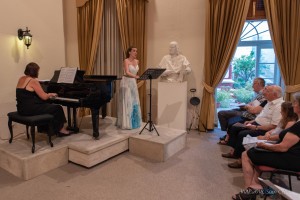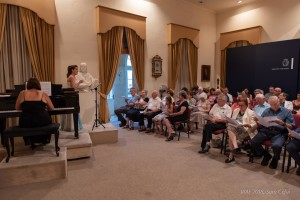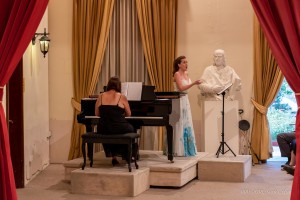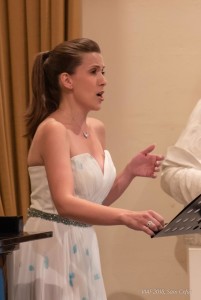A versatile Rosabelle Bianchi
Vocal recitals are always attractive, especially so when they do not present run-of-the-mill works. The concert presented by soprano Rosabelle Bianchi accompanied by pianist Julia Miller on Saturday 30 June attested to the singer’s versatility in terms of style, genre, and mood.
Rosabelle possesses a very beautiful, warm voice, with a particular depth and mellowness in the middle range. She started her recital with Mozart’s Deh! Vieni non tardar from Le Nozze di Figaro. This aria is always a good one to start off a concert with: it allows the voice to settle by engaging with a cantabile melodic line. It also asks for an extreme legato phrasing which is a strong building block for any technical difficulty to overcome. Rosabelle sang this piece beautifully, weaving an emotionally-controlled tapestry with a silken thread, maintaining a classic poise and balance that never overreached or overwhelmed.
The mettle of any singer is always tested when Lieder is attempted. There was a diversity of such genre in the evening’s recital, ranging from Schubert to Schumann to Richard Strauss. Moving seamlessly from one style (and language) to the other, one was particularly impressed by Schubert’s famous Gretchen am Spinnrade, a veritable spinning-wheel of a piece that whirs and twirls with seemingly inexhaustible power and energy. Schubert enhances the emotional tension through harmonic means, moving over the course of the verse from D minor, up to E, then F. In addition, he alters the text delivery so that the ominous opening lines reappear throughout the song, always pulling the harmony back to the original key. The most striking moment in the piece occurred as Gretchen, with an exhilarating fortissimo ascent to B flat major, thinks of her lover’s kiss, at which point she can maintain the pretence of work no longer: having worked herself into a fit, she stops spinning completely, and only after several faltering efforts is she able to regain her composure and resume her task. She voices a wish for death upon his bosom, then utters once again the sorrowful refrain. This piece was delivered with panache and passion. Worthy of mention at this point was the supremely stable and exciting piano playing by Julia Miller.
‘Du bit wie eine blume’ by Schumann is a ravishing little gem that uses flower imagery as a metaphor of his fiancée, Clara Wieck. Hardly sentimental, its obeisant, melancholic mood touches on the realistic, decaying influence of the world on a maiden’s fairness and purity. Rosabelle Bianchi tackled this slow rich work intelligently: it is primarily made of beamed sixteenth notes and its final measure contains a triplet grace note like that of Morgens steh’ ich auf und frage op. 24/1 which was impeccably tackled. Apart from requiring vocal restraint to perform its ritardandos as slowly and quietly as indicated, sensitivity was also applied to the other grace notes and to the double meaning of the words’ sounds.
One of Richard Strauss’ best known songs, Morgen is a celebration of love, inspired by the composer’s feelings toward his wife, Pauline. The text is ‘Morgen’, a poem by the German poet (of Scottish extraction), John Henry Morgan (1864-1933). The poem, which blends tranquil, reassuring images of nature with deep confidence in love, inspired a natural, flowing melody of extraordinary beauty. In the evening’s interpretation, while the atmosphere of tranquillity remained fundamentally undisturbed, the smoothly ascending movement of the melody suggested feelings of deep, boundless joy, yearning to express its immensity. Providing discreet harmonic accompaniment and gentle melodic support, the piano part beautifully complemented the solo.
Donaudy’s O del mio amato ben is another beautiful aria, this time consisting of a blend of Baroque and Romantic vocal writing techniques which not only succeeds in creating a cohesive whole but in weaving a particularly lovely and memorable musical work. It started with a delicate, very subtly ornamented theme that was reminiscent of the arias of Caldara, echoed in the accompaniment, and then slowly rose to a passionate declamation as warm and flowing as any of Donizetti’s bel canto pieces. It finally returned cyclically to its earlier theme.
A marked departure in mood and style occurred with the next piece on the programme, namely, Massenet’s Elégie. The melody of the Elégie seems to have cried out for words from the beginning and is a study in deeply felt yet restrained Romanticism, of resigned longing for the past. In structure and mood it is also reminiscent of Chopin’s E minor Prelude, with which it shares a common key (in most arrangements). The main phrase is made up of a yearning octave leap and sighing descent, and on this germinal idea the song is built. A brief excursion into the relative major aspires to relieve. Towards the end there is an intriguing suggestion of bitonality but this tension quickly resolved back to melancholy to close this perfectly formed miniature. A utterly beautiful rendering was given by Rosabelle and Julia!
Fauré’s Après un rêve is a firm favourite with recitalists. This is a highly descriptive, rhapsodic song, an apostrophe extolling the virtues of love. Recovering from his dream, the lover whimsically says that love is sacred, a prayer in itself, the embodiment of all that is true and beautiful, paradoxically permanent and stabilising in perpetual flux. The same mood pervaded Joseph Vella’s very early song, Waħdi op. 13, one of wistful longing and quiet nostalgia. Typical of the composer, his genius for melodic beauty and juxtaposing traditional forms with contemporary harmonic textures marked the fabric of the piece. Both these songs were delivered in a balanced manner, injecting them with the right dose of emotional angst yet never verging on the exuberant and operatic.
With Rossini’s Crucifixus, the performers ventured into sacred music, although there is always a gentle dose of operatic excess in any Rossini aria, no matter how sacred it is! This work is built on a short motif that built up and increased in stature and magnanimity. It could be described an exercise in word-painting as the music brilliantly evoked the words being spoken. It demanded great breath control especially as it scales the upper reaches of the vocal spectrum and plunged to the lowest at times as well, a technical obstacle that was quite well-managed by the singer. Harmonically it is very interesting in that it makes forays into unrelated keys, cumulatively building intensity in typical Rossini style.
A Ponchielli song and two others by Mascagni (both of whom are better known as masters of opera writing), provided some light relief although in no way one means that these works were easy. The former’s Non leggeviamo insieme was characterised by a seductive melody which unravelled against a gently rippling accompaniment on the pianoforte, while Mascagni’s La tua stella and Serenata attested to the glorious tradition of Italian bel canto.
The recital ended with Alfano’s Dio pietoso from his opera La Risurrezione. Starting with a recitativo accompagnato the aria made considerable demands on the vocal technique and musicality of the singer. Pregnant with feeling and foreboding, this very beautiful piece could very easily find its way into a Puccini dramatic score such as a Madama Butterfly or a Tosca. Scaling both the tonal and dynamic ranges of the vocal spectrum, it came across as at once powerful and endearing.
This was one recital that displayed the maturity, intelligence and vocal beauty of the soprano, together with the soundness and reliability of a very experienced pianist!








